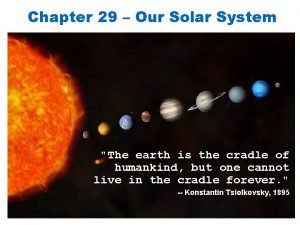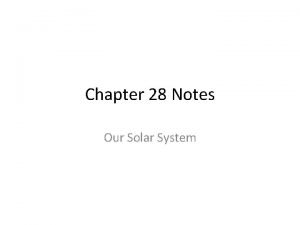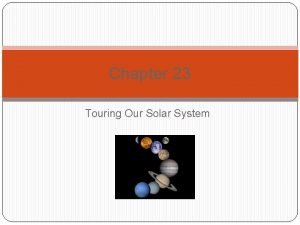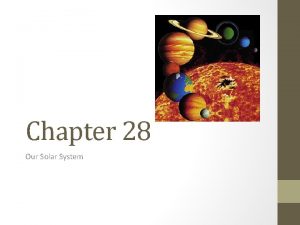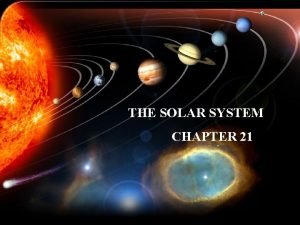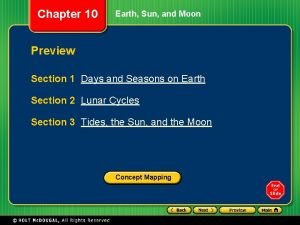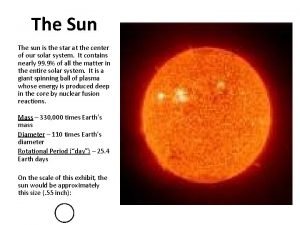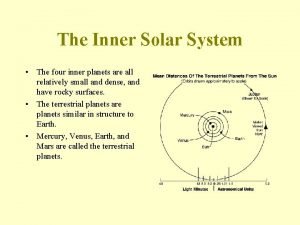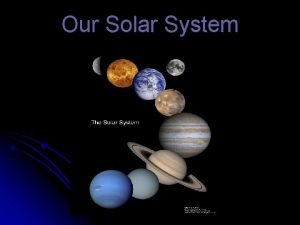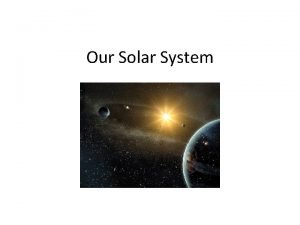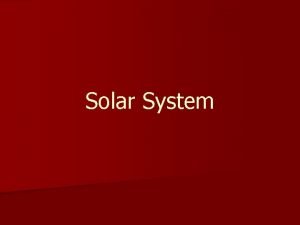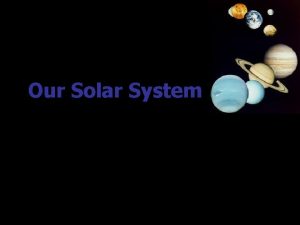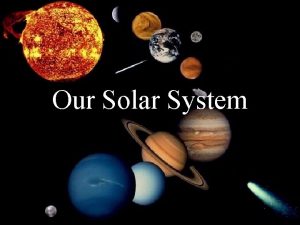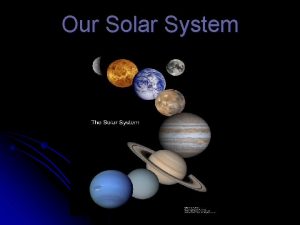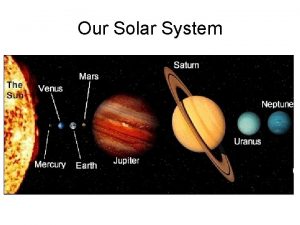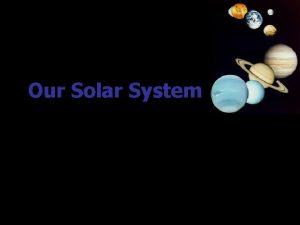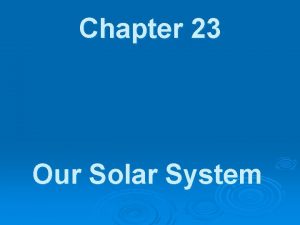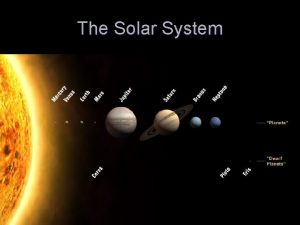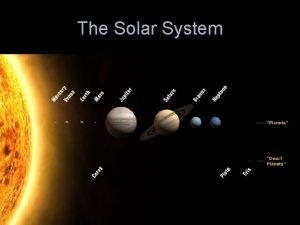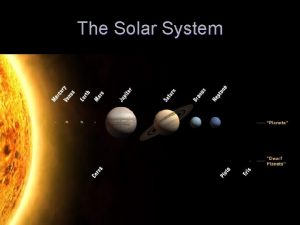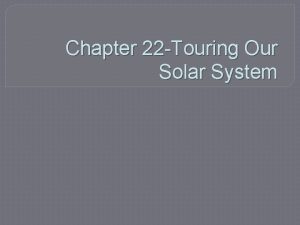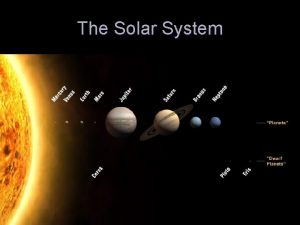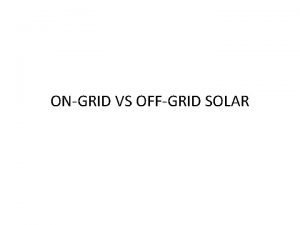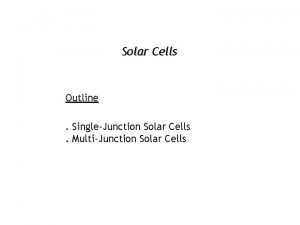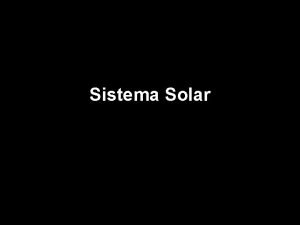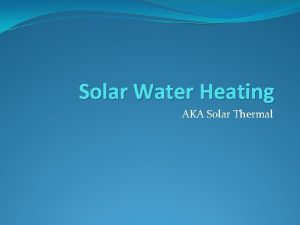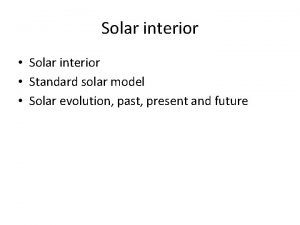The Solar System THE SOLAR SYSTEM CHAPTER 21






















































- Slides: 54

The Solar System THE SOLAR SYSTEM CHAPTER 21 Chapter 20 & 21

The Sun: The Center of Our Solar System 1. Main sequence star 2. Wider than 100 Earths n 10, 000 °F on surface & 27, 000 °F in its core n less bright & massive than the very largest stars Although its mass = 2, 000, 000, 000 tons n This makes it more massive than 80% of all stars. n A truly "typical" star has a mass perhaps 1/4 of that of the Sun and is considerably less luminous (bright).

Different Views of The Sun 3 -D Image of the sun Normal Telescopic Image of the sun UV Image of the sun

Distances of the Inner Planets from the Sun in Astronomical Units 150 million km (about 93 million miles) = 1 AU

The Inner Planets or Terrestrial Planets 1. Dense and Rocky 2. Mercury 3. Venus 4. Earth 5. Mars n They are solids & close to the sun because the materials that make them can be a solid at high temperatures.

The Inner Planets INNER PLANETS

Mercury 1. 1/3 wide as Earth 2. No moons; resembles our moon because of all of its craters 3. Big, grey rock made of iron 4. 2 nd hottest planet & smallest 5. Revolves around the sun in 88 days 6. Rotates on its axis every 58 days § 1. 5 days on Mercury = 88 days on Earth 7. Temperature varies -173°C (343°F) to 427°C (800°F) since it lacks a protective atmosphere. ► Temperature variations on Mercury are the most extreme in the solar system.

Mercury In Roman mythology Mercury is the god of commerce, travel and thievery, the Roman counterpart of the Greek god Hermes, the messenger of the Gods. The planet probably received this name because it moves so quickly across the sky. Mercury has been known since at least the time of the Sumerians (3 rd millennium BC). It was given two names by the Greeks: Apollo for its apparition as a morning star and Hermes as an evening star. Greek astronomers knew, however, that the two names referred to the same body. Heraclitus even believed that Mercury and Venus orbit the Sun, not the Earth. http: //www. nineplanets. org/mercury. html

Venus 1. Earth’s twin —its size is almost as big as Earth 2. No moons; thick yellow clouds of acid 3. Dense nickel & iron planet w/a molten core; covered by many shield volcanoes (largest one is Sif Mons) 4. Hottest planet in solar system at 464°C (867°F) due to its thick atmosphere —exerts 90% times more pressure than the Earth’s atmosphere (would be like being 1 km deep in the ocean to stand on Venus) 5. Atmosphere made of carbon dioxide (90%) & sulfuric acid, which creates a monstrous greenhouse effect. 6. Had water @ one point but it all boiled away.

Venus (Greek: Aphrodite; Babylonian: Ishtar) is the goddess of love and beauty. The planet is so named probably because it is the brightest of the planets known to the ancients. (With a few exceptions, the surface features on Venus are named for female figures. ) Venus has been known since prehistoric times. It is the brightest object in the sky except for the Sun and the Moon. Like Mercury, it was popularly thought to be two separate bodies: Eosphorus as the morning star and Hesperus as the evening star, but the Greek astronomers knew better. (Venus's apparition as the morning star is also sometimes called Lucifer. ) http: //www. nineplanets. org/venus. html

Earth 1. “Third rock from the sun, ” made completely of rock; core made of iron & nickel; has magnetic field lines 2. 1 moon—Luna 3. Temperatures range from -13°C (8°F) to 37°C (98°F) 4. Densest planet in our solar system; has water in all 3 states of matter (solid, liquid, & gas) 5. 5 th largest planet in solar system

Earth is the only planet whose English name does not derive from Greek/Roman mythology. The name derives from Old English and Germanic. In Roman Mythology, the goddess of the Earth was Tellus - the fertile soil (Greek: Gaia, terra mater - Mother Earth). It was not until the time of Copernicus (the sixteenth century) that it was understood that the Earth is just another planet. http: //www. nineplanets. org/earth. html

Earth’s Moon: Luna (384, 400 km from Earth) Called Luna by the Romans, Selene and Artemis by the Greeks, and many other names in other mythologies. The Moon, of course, has been known since prehistoric times. It is the second brightest object in the sky after the Sun. As the Moon orbits around the Earth once per month, the angle between the Earth, the Moon and the Sun changes; we see this as the cycle of the Moon's phases. The time between successive new moons is 29. 5 days (709 hours). http: //www. nineplanets. org/luna. html

Mars 1. The red planet —red from rust, meaning that it had water on it at one time 2. Once had water on it; has polar ice caps that have both frozen water & carbon dioxide in them 3. Many scientists believe that most of Mars’ water lies frozen beneath Mars’ soil 4. Has 2 volcanoes —Tharsis (8, 000 km wide – 4, 971 mi. ) & Olympus Mons—an extinct shield volcano 5. Temperature ranges: -123°C (-189°F) to 37°C (98°F) 6. Revolution: 1 yr, 322 days 7. 2 moons: Phobos & Deimos (mean fear & panic)

Phobos ("FOH bus") is the larger and innermost of Mars' two moons. Phobos is Greek for “fear. ”Phobos is closer to its primary than any other moon in the solar system, less than 6000 km (3, 728 miles) above the surface of Mars. It is also one of the smallest moons in the solar system. http: //www. nineplanets. org/phobos. html

Deimos ("DEE mos") is the smaller and outermost of Mars' two moons. It is one of the smallest known moons in the solar system. In Greek mythology, Deimos is one of the sons of Ares (Mars) and Aphrodite (Venus); "deimos" is Greek for "panic".

Mars (Greek: Ares) is the god of War. The planet probably got this name due to its red color; Mars is sometimes referred to as the Red Planet. (An interesting side note: the Roman god Mars was a god of agriculture before becoming associated with the Greek Ares; those in favor of colonizing and terraforming Mars may prefer this symbolism. ) The name of the month March derives from Mars.

Mars—Home to the largest volcano in the solar system Olympus Mons is the largest volcano on Mars. This shield volcano, similar to volcanoes in Hawaii, measures 624 km (374 mi) in diameter by 25 km (16 mi) high. It is 100 times larger than Mauna Loa on Earth. Located on the Tharsis Plateau near the equator, Olympus Mons is bordered by an escarpment. The caldera in the center is 80 km (50 mi) wide and contains multiple circular, overlapping collapse craters created by different volcanic events. The radial features on the slopes of the volcano were formed by overflowing lava and debris.

The Asteroid Belt 1. Small, rocky bodies that revolve around the sun § Made of leftovers from the formation of the universe 2. Range in size from a few meters to greater than 900 km (559 miles) in diameter 3. Irregular shapes, but larger ones are spherical 4. Most orbit the sun in the asteroid belt —a region of space b/w Mars & Jupiter 5. Asteroids vary in color depending on their location in the asteroid belt § Outermost region = reddish brown to black (organic composition) § Innermost region = gray (carbon); light gray = stony/metallic

Hektor Famous Asteroids Ida and Dactyl http: //neo. jpl. nasa. gov/images/ida. html

Ceres: the largest of the asteroids Observations of 1 Ceres, the largest known asteroid, have revealed that the object may be a "mini planet, " and may contain large amounts of pure water ice beneath its surface. http: //www. spaceflight now. com/news/n 0509/ 07 ceres/

Meteoroids: “cousins” to asteroids; shooting stars 1. Much smaller than asteroids but very similar 2. Meteoroids are small, rocky bodies that revolve around the sun. 3. Once it enters Earth’s atmosphere it becomes a meteor & stays a meteor if it burns up in the atmosphere. 4. If it strikes the ground it is a meteorite.

Meteoroids continued 1. 3 types: A. Stony—rocky material B. Metallic—iron & nickel C. Stony-iron—rocky, iron & nickel

Rocky Meteorites http: //meteorites. asu. edu/images/new-concord-big. jpg

Metallic Meteorites http: //www. astro. virginia. edu/class/oconnell/astr 121/im/iron-meteorite. jpg

Stony-iron Meteorites http: //www. gpc. edu/~pgore/myphotos/rocks/stonyironmeteor. jpg

Meteorite Crater In Canyon Diablo in Arizona, USA, you can visit the best preserved meteorite crater on earth. It was formed about 22, 000 years ago by the impact of a giant metallic nickel-iron meteorite, which arrived from space at a speed of about 50, 000 kilometers per hour (31, 000 mph), and weighed many hundreds of tons. Friction with the atmosphere does not really slow such a mighty mass, which smashed into the solid earth, punching away 300 million tons of rock in a mighty blast which left a crater which even today is still 1. 5 kilometers (1 mile) in diameter and 170 meters (558 ft. ) deep. (http: //www. rocksonfire. com/About-Meteorites. htm)

The Outer Planets or Gas Giants 1. Jupiter 2. Saturn 3. Uranus 4. Neptune 5. All are made of gas. They are not solids like the inner planets. n They get denser with increasing depth. 6. All have rings. 7. Since their masses are so much larger, they have more moons than the inner planets.

Astronomical Units –Outer Planets (150 million km = 1 AU) 1. Jupiter 5. 203 AU 2. Saturn 9. 539 AU 3. Uranus 19. 18 AU 4. Neptune 30. 06 AU

Jupiter 1. The largest planet in our solar system (318 times as large as Earth) § Its mass holds the asteroid belt in place & protects Earth from asteroid assault. 2. Made mainly of hydrogen & helium 3. Cold planet; average temperature = -110°C (-166 F) 4. Great Red Spot (1. 5 X the size of the Earth) is a storm system similar to a hurricane that is > 400 yrs old. 5. Rotation = 9 hrs, 54 min 6. Revolution = 11 yrs, 313 days

Jupiter (continued) 8. Has 63 moons as of Feb. 2004 9. 4 largest: Io, Europa, Ganymede and Callisto 10. Has rings like Saturn, but much fainter & smaller

Jupiter: http: //www. nineplanets. org/jupiter. html Roman god Jupiter (Greek Zeus) was the King of the Gods, the ruler of Olympus and the patron of the Roman state. Jupiter is the fourth brightest object in the sky (after the Sun, the Moon and Venus). It has been known since prehistoric times as a bright "wandering star". But in 1610 when Galileo first pointed a telescope at the sky he discovered Jupiter's four large moons and recorded their motions back and forth around Jupiter.

Jupiter’s Rings 1. Unlike Saturn's, Jupiter's rings are dark. 2. They're probably composed of very small grains of rocky material. Unlike Saturn's rings, they seem to contain no ice.

Saturn 1. 2 nd largest planet in the solar system (95 X larger than Earth) 2. Composed mainly of hydrogen & helium w/a small rocky core. 3. Average temperature = -140°C (-220°F) 4. Saturn’s rings are the largest of the gas giants. 5. Made of icy particles that range from a few cm to a few m wide. 6. Revolution: 29 years, 155 days 7. Rotation: 10 hrs, 42 min 8. 31 moons

Saturn In Roman mythology, Saturn is the god of agriculture. The associated Greek god, Cronus, was the son of Uranus and Gaia and the father of Zeus (Jupiter). Saturn is the root of the English word "Saturday“. http: //www. nineplanets. org/saturn. html

Saturn’s Rings 1. Saturn’s rings are 250, 000 km (155, 342 mi. ) or more in diameter & they're less than one kilometer thick. http: //www. nineplanets. org/saturn. htm l

Uranus 1. Super cold -195°C (319 F) 2. 21 moons 3. Revolution: 83 yrs, 273 days 4. Rotation: 17 hrs, 12 min 5. 11 rings 6. 3 rd largest planet 7. Rotates on its side---planet was probably knocked on its side after a collision w/an asteroid – One side points toward the sun & the other in complete darkness for part of the year 8. Made of hydrogen & methane — 2 gases that absorb red light, giving Uranus its distinct blue/green color

Uranus is the ancient Greek deity of the Heavens, the earliest supreme god. Uranus, the first planet discovered in modern times, was discovered by William Herschel while systematically searching the sky with his telescope on March 13, 1781. http: //www. nineplanets. org/uranus. html

Uranus’ rings http: //hubblesite. org/newscenter/archive/releases/1996/15/image/a/format/web/

Neptune: Big Blue World 1. 11 moons 2. Rotation: 16 hrs, 6 min. 3. Revolution: 163 yrs, 263 days 4. Temperature: -200 °C (-328 F) 5. Has dark rings 6. Neptune & Pluto’s orbits overlap causing Neptune to be further out than Pluto

Neptune: Big Blue World 1. Gets its blue color from being made of methane gas that absorbs red light, making Neptune appear blue 2. Has belts of clouds & a great Dark Spot similar to Jupiter’s great Red Spot 3. Tilted at a 30° angle so its poles are in light or dark for 40 yrs @ a time

Neptune The Great Dark Spot In Roman mythology Neptune (Greek: Poseidon) was the god of the Sea. http: //www. nineplanets. org/neptune. html

Neptune’s Dark Rings

Kupier Belt (pronounced kew p a) n A region in space beyond Neptune where @ least 70, 000 small, icy, slowmoving objects orbit the sun n A region where the planet-building process stopped before any large objects where formed n Pluto & is moon Charon (pronounced Sharon) are thought to be large members of it n Short-lived comets like Haley’s comet are also thought to come from the Kupier Belt n Discovered in 1992 by Dutch-American astronomer Gerard P. Kupier


Oort Cloud ► A large sphere that surrounds the solar system ► Where the bulk of comets originate ► Suggested by astronomer Jan Oort in 1950 ► Both the Kupier Belt & the Oort Cloud are relatively pristine remnants of the nebula from which the entire solar system was formed. ► Could contain as many as a trillion comets http: //www. nineplanets. org/kboc. html

http: //www. fas. org/irp/imint/docs/rst/Sect 19/H_oort-cloud_02, 0. jpg

Comets http: //www. nineplanets. org/comets. html

Comets n Comets are sometimes called dirty snowballs or "icy mudballs". They are a mixture of ices (both water and frozen gases) and dust that for some reason didn't get incorporated into planets when the solar system was formed. This makes them very interesting as samples of the early history of the solar system. n When they are near the Sun and active, comets have several distinct parts: nucleus: relatively solid and stable, mostly ice and gas with a small amount of dust and other solids; coma: dense cloud of water, carbon dioxide and other neutral gases sublimed from the nucleus; hydrogen cloud: huge (millions of km in diameter) but very sparse envelope of neutral hydrogen; dust tail: up to 10 million km (6 million mi. ) long composed of smoke-sized dust particles driven off the nucleus by escaping gases; this is the most prominent part of a comet to the unaided eye; ion tail: as much as several hundred million km long composed of plasma and laced with rays and streamers caused by interactions with the solar wind. http: //www. nineplanets. org/comets. html

Sedna • Large planetoid or asteroid • More than 2 X as far from the sun as Pluto • Huge ball of ice, w/reddish color • Revolves around the sun once every 10, 500 yrs • The coldest most distant place known in the solar system; possibly the first object in the longhypothesized Oort cloud

90 AU

Sedna—what we think it looks like Sedna's physical composition is a bit of a mystery. You would expect it to be mostly ices but apparently that's not the case. About all that's known at this time is that it is very red and that water and methane ices seem to be absent on the surface. Sedna is definitely not the "Planet X" that many astronomers anticipated before the discovery of Pluto. Planet X was supposed to be a much larger object. http: //www. nineplanets. org/sedna. html

Eris—the next “dwarf planet” • • Officially named in 9/2006 Named for the goddess of chaos & strife 1 moon = Dysomia: Spirit of lawlessness Eris, the largest dwarf planet known • The dwarf planet is the most distant object ever seen in orbit around the sun, even more distant than Sedna, the planetoid discovered almost 2 years ago. It is almost 10 billion miles from the sun and more than 3 times more distant than the next closest planet, Pluto and takes more than twice as long to orbit the sun as Pluto.

Xena • Another planetoid that will probably become another “dwarf planet” in the coming months • It's the largest nonstellar object now known to exist beyond the orbit of Neptune. And, at roughly 97 AU, or Astronomical Units (one AU equals the Earth's distance from the Sun, about 93 million miles) it's also the most distant.
 Buy wholesale solar panels
Buy wholesale solar panels An inexhaustible source of energy
An inexhaustible source of energy Chapter 29 our solar system
Chapter 29 our solar system Chapter 28 our solar system
Chapter 28 our solar system Chapter 23 touring our solar system
Chapter 23 touring our solar system Chapter 28 our solar system
Chapter 28 our solar system I became a system chapter 21
I became a system chapter 21 Hát kết hợp bộ gõ cơ thể
Hát kết hợp bộ gõ cơ thể Bổ thể
Bổ thể Tỉ lệ cơ thể trẻ em
Tỉ lệ cơ thể trẻ em Chó sói
Chó sói Glasgow thang điểm
Glasgow thang điểm Chúa sống lại
Chúa sống lại Các môn thể thao bắt đầu bằng từ đua
Các môn thể thao bắt đầu bằng từ đua Thế nào là hệ số cao nhất
Thế nào là hệ số cao nhất Các châu lục và đại dương trên thế giới
Các châu lục và đại dương trên thế giới Công thức tính thế năng
Công thức tính thế năng Trời xanh đây là của chúng ta thể thơ
Trời xanh đây là của chúng ta thể thơ Cách giải mật thư tọa độ
Cách giải mật thư tọa độ 101012 bằng
101012 bằng Phản ứng thế ankan
Phản ứng thế ankan Các châu lục và đại dương trên thế giới
Các châu lục và đại dương trên thế giới Thể thơ truyền thống
Thể thơ truyền thống Quá trình desamine hóa có thể tạo ra
Quá trình desamine hóa có thể tạo ra Một số thể thơ truyền thống
Một số thể thơ truyền thống Bàn tay mà dây bẩn
Bàn tay mà dây bẩn Vẽ hình chiếu vuông góc của vật thể sau
Vẽ hình chiếu vuông góc của vật thể sau Nguyên nhân của sự mỏi cơ sinh 8
Nguyên nhân của sự mỏi cơ sinh 8 đặc điểm cơ thể của người tối cổ
đặc điểm cơ thể của người tối cổ Ví dụ giọng cùng tên
Ví dụ giọng cùng tên Vẽ hình chiếu đứng bằng cạnh của vật thể
Vẽ hình chiếu đứng bằng cạnh của vật thể Fecboak
Fecboak Thẻ vin
Thẻ vin đại từ thay thế
đại từ thay thế điện thế nghỉ
điện thế nghỉ Tư thế ngồi viết
Tư thế ngồi viết Diễn thế sinh thái là
Diễn thế sinh thái là Dạng đột biến một nhiễm là
Dạng đột biến một nhiễm là Các số nguyên tố
Các số nguyên tố Tư thế ngồi viết
Tư thế ngồi viết Lời thề hippocrates
Lời thề hippocrates Thiếu nhi thế giới liên hoan
Thiếu nhi thế giới liên hoan ưu thế lai là gì
ưu thế lai là gì Sự nuôi và dạy con của hươu
Sự nuôi và dạy con của hươu Khi nào hổ con có thể sống độc lập
Khi nào hổ con có thể sống độc lập Hệ hô hấp
Hệ hô hấp Từ ngữ thể hiện lòng nhân hậu
Từ ngữ thể hiện lòng nhân hậu Thế nào là mạng điện lắp đặt kiểu nổi
Thế nào là mạng điện lắp đặt kiểu nổi Solar eclipse chapter 10
Solar eclipse chapter 10 Solar system webquest answer
Solar system webquest answer Swedish solar system
Swedish solar system Uranus distance from sun
Uranus distance from sun Nebular theory comic strip
Nebular theory comic strip What are the four inner planets
What are the four inner planets


